A magnetic field was a way of drawing lines around a magnet to show the direction and the strength of the push or pull one magnet exerts on another.
Here is a plot of the magnetic field lines of a common horseshoe magnet.
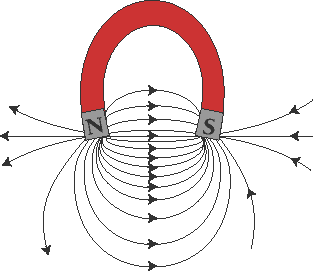
Given an horseshoe magnet and some paper clips, how can we "map" these field lines ourselves?
What about forces on electric charges? Remember when we observed how (like charged) styrofoam pellets were repelled from a charged Van de Graaf generator?
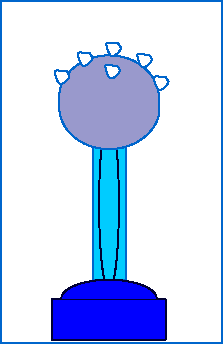
How do we draw electric field lines showing the direction and strength of this electric force?
Electric and magnetic fields are just a way to show where electric and magnetic forces point. By convention, the density of field lines indicates the strength of the electric or magnetic field.
Even the Earth has a magnetic field!
What was necessary to generate electricity using our coil and bar magnet?
For one, we had to move the magnet. Holding the magnet still just didn't cut it. When we move the magnet, we move the magnetic field.
Now imagine yourself sitting at one point on our wire. You have a special meter to measure the magnetic field, and you do so each second. When the magnet is moved, you would find that the magnetic field changes over time.
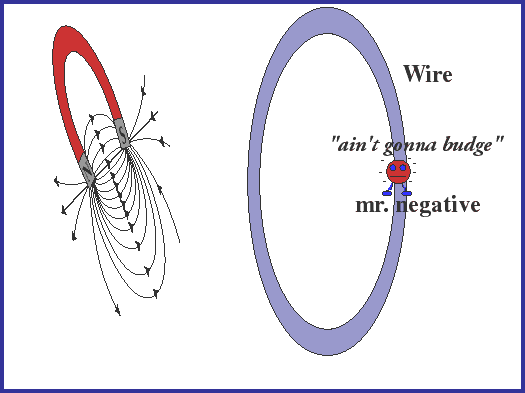
One condition necessary for moving charges on the wire (making current, ergo electricity) is having the magnetic field change over time.
What about the other side of the coin? When we moved charge down a wire (carrying a current), we observed a magnetic field. Each charge moving along the wire would exhibit an electric field. Sitting at one point on the wire, you would observe an electric field that changes over time. So...
One necessary condition for making a magnetic field from a current is to have an electric field that varies over time.
Imagine that you are sitting in a rowboat fishing on a placid lake. The neighborhood speed-boat bully goes whizzing by in his 500 hp (373,000W) speedboat. What happens to your rowboat? You already know. You bob up and down, spilling your non-alcoholic beverage, and knocking over your bait box so that the worms fall into your lunch. Here is the situation depicted graphically:
- (source: Energy- G. Aubrecht)
Note that you bob up and down regularly, that is if you were to measure the time between the top of successive waves, it would be the same each time. The time between the tops of two successive waves is called the period, T, of the wave. Long-period waves give you more time between each peak to rescue your lunch from the worms.
The inverse of period is frequency, f, or:
The long-period waves that give you time to rescue your lunch are low-frequency waves. High-frequency waves, those with short time periods between the peaks, might make you seasick.
If you were to take a snapshot of your boat on top of one wave, it might look like this. At any given instant in time, the distance between peaks is called the wavelength. The wavelength is somewhat analagous to period. You measure the period by measuring the time between wave tops at a given position. You measure wavelength by measuring the distance between wavetops at a given time.
- (source: Energy- G. Aubrecht)
Eventually the waves die down and you can resume fishing. What happened? The waves were traveling across the surface of the lake, moving past your boat to go and bother someone else. It turns out that the speed with which the crest of a particular wave travels is related to the wavelength and frequency, like this:
where lambda (l) represents the wavelength. Think about this relationship in terms of the units of measurement. Wavelength can be measured in meters (m). Frequency is measured in Hertz (1/sec). Hence, wavelength x frequency gives units of m/s, our standard units for measuring velocities.
Wave speed is a fundamental property of the medium.
Sound: There are many examples of wave phenomenon in nature. Sound is just an alternating compression and rarefication of air or some other supporting media (e.g., water). Sound waves travel faster in water than they do in air. So the velocity is a characteristic of the medium.
Seismic waves are sound waves that travel through the Earth. Their velocity changes according to the type of rock and the pressure it is under. If you were sitting on a rock within the Earth as a seismic wave passed by, you would be bounced up and down (or side to side), just as you were in the boat.
Light waves are a special kind of electromagnetic wave (EM wave). X-rays and infra-red waves from heat lamps are other kinds of electromagnetic waves. Taken together, radio waves, microwaves, infra-red, visible light, ultraviolet and x-rays constitute electromagnetic radiation.
Waves provide a way to transport energy from one point to another. The wiggling air, rock, or electrical and magnetic fields that comprise waves can do work at a distant location.
So here is where we stand. We know that:
One could imagine that a changing magnetic field could cause charges to wiggle. These wiggling charges would make another changing magnetic field. If things are done right, maybe we could propagate this field from one point to another.
But wait! It says above that EM waves don't require a medium to travel across. They can cross empty space, for example, from the sun to the earth.
James Clerk Maxwell figured out how this works. EM waves don't need something to travel across. The changing magnetic field makes a changing electric field. The changing electric field makes a varying magnetic field. And so on and so forth.
Electromagnetic waves, comprising time-varying electric and magnetic fields, can travel across empty space. When radio (EM) waves strike your antenna, the charges in the antenna want to wiggle. Their wiggling causes an alternating current in the antenna. Information such as voices, sound, tv signals, etc. can be encoded in this alternating current. You radio or tv set can decode these signals and reproduce them for you.
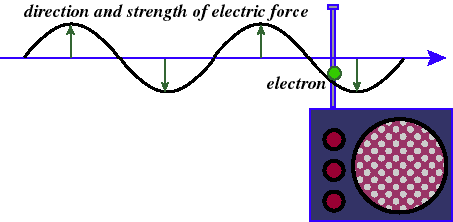
{note: the electron on the antenna does not necessarily "follow" the sine wave representing the electric field. The latter shows the force on the electron and, consequently, its acceleration. Its position along the antenna would be derived from its initial position and acceleration over time.}
The frequency at which an electromagnetic wave oscillates determines what we call it:
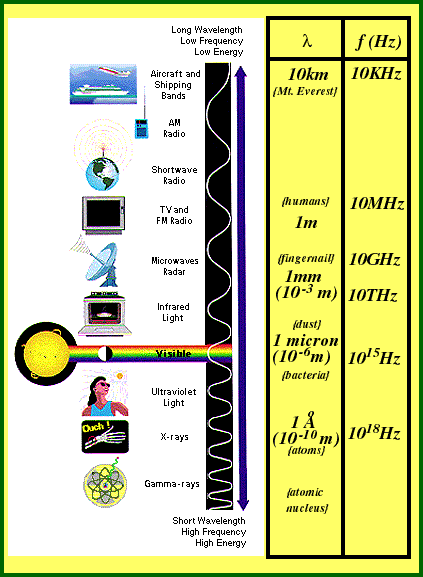
{adopted from Imagine! the Universe Home Page}
Many forms of solar collectors have been built to convert radiation from the sun into thermal energy used to heat living space and help heat domestic hot water. Some collectors uses mirrored surfaces or parabolic reflectors to concentrate sunlight shining on a black-colored, water-filled pipe. These are called concentrator collectors.
A less exotic and cheaper form of collector consists of an insulated box containing a metalic plate through which water or some other heat storage medium can flow. The top of the box is covered with 2 or more sheets of glass.
{source: Energy & Problems of a Technical Society- Kraushaar & Ristenen}
Sunlight striking the black colored plate results in an increase of internal energy of the collector plate-- the atoms in the plate vibrate more vigorously than without sunlight.
This thermal energy is transferred to water, for example, and the water is either pumped out, or passively convects out of the top of the collector. The water flows to a storage tank, where it transfers it heat energy directly to the air in the house or to the domestic hot water supply.
{source: Energy & Problems of a Technical Society- Kraushaar & Ristenen}
Solar collectors work on the mini-greenhouse effect principle. The sun radiates its energy in the infrared (IR), visible and ultraviolet (UV) spectra. Certain gas molecules in the Earth's atmosphere (can you guess which ones?) absorb much of the radiation in the UV and low IR frequency ranges, leaving most of the energy in the visible spectra.
(source: Energy & Problems of a Tech. Society- Kraushaar & Ristenen, absorption lines adopted from Piexoto & Oort, Physics of Climate)
So most of the energy of solar radiation reaching the Earth's surface is concentrated in the visible and upper IR spectra.
A typical collector absorber (plate) will heat up to just below the boiling point of water, 200 degrees Farenheit. It will therefore radiate EM waves like a black body with this temperature, emitting mostly infrared radiation. (We'll get to black bodies later on).
Glass is quite transparent to visible light but reflects IR radiation well. Consequently, much of the energy lost to radiation from the collector plate is trapped within the collector, and can further heat the water passing through the absorber plate. A graph showing the frequencies where solar and collector plate radiation occurs is given below:
{original source: The Sun: Our Future Energy Source- D. McDaniels}
So this "radiative heat energy transfer" from Sun to home involves a change in the EM wave frequencies that are involved. Energy from the Sun is transferred to the Earth as IR, visible and UV EM radiation. The solar collector "converts" this energy into usable heat energy at a lower frequency. Though the panel will re-radiate some of this heat upwards, the glass in the collector will trap it within.
This model for solar collectors assumes that objects emit frequencies of EM radiation according to their temperature. The sun is very hot (~5700Kelvin), and consequently emits EM radiation at high frequencies (visible light, etc.). We call this range of frequencies the Sun's spectrum.
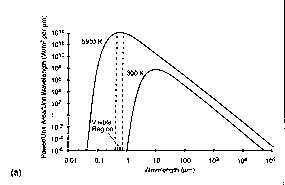
The solar collector is not as hot (~373K), thank goodness! It radiates EM waves at much lower frequencies, which we perceive as "heat."